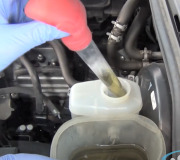You're describing the typical symptom of a warped brake rotor. There's no chance at all you will see that with a visual inspection. There's two ways a rotor can warp, but it takes as little as a few thousandths of an inch to feel it. The thickness can vary from one area to the other. That forces the brake pads to move apart and push brake fluid back up to the master cylinder, and brake pedal, where you'll feel the pedal pulse up and down. That's called "thickness variation?
The second way this can happen is to imagine the friction surfaces on the rotor are perfectly parallel to each other, but the mounting face is turned or tipped slightly. There's a good chance you won't feel a pedal pulsation, but as the rotor spins, it causes the caliper to moved back and forth sideways. That can also be just a few thousandths of an inch, but you will see and feel that in the steering wheel. The same thing can happen if a piece of scale or debris gets stuck behind the rotor's mounting surface during other routine services. It makes the rotor sit crooked on the hub, so it wobbles as it spins.
Either condition is solved by a simple machining. Most repair shops can do that and many auto parts stores can do it too. This same type of warping can occur to brand new rotors within three months of being put into service. Machining them one time is all that's needed. They rarely warp again after that.
The only stipulation when machining rotors is there's a published legal minimum thickness they can be machined to, and a slightly thinner limit they can be allowed to wear to. No reputable repair shop will machine them for you if they're going to end up too thin. Most rotors today start out very close to those minimums to save weight, so often a rotor with high mileage can't be machined even once. The good news is replacement rotors are very inexpensive for most models.
Here's links to some related articles you might find interesting:
https://www.2carpros.com/articles/how-to-replace-brake-rotors-correctly
https://www.2carpros.com/articles/how-to-replace-front-brake-pads-and-rotors-fwd
Friday, June 21st, 2024 AT 11:49 AM


